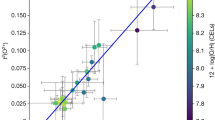Abstract
The primordial \({}^{4}\)He abundance (Y\({}_{p}\)) is one of the key characteristics of Primordial Nucleosynthesis processes that occurred in the first minutes after the Big Bang. Its value depends on the baryon/photon ratio \(\eta\equiv n_{b}/n_{\gamma}\), and is also sensitive to the relativistic degrees of freedom which affect the expansion rate of the Universe at the radiation-dominated era. At the moment, the most used method of the determination of Y\({}_{p}\) is the study of the metal deficient H II regions located in blue compact dwarf galaxies (BCDs). In this paper, we discuss in detail various methods of the determination of H II region metallicity in the context of Y\({}_{p}\) analyses. We show that some procedures used in the methods lead to biases in the metallicity estimates and underestimation of their uncertainties. We propose a modified method for the metallicity determination, as well as an additional criterion for selecting objects. We have selected 69 objects (26 objects with high quality spectra from the HeBCD+NIR database and 43 objects from the SDSS catalog), for which we estimate Y and O/H using the proposed method. We have estimated Y\({}_{p}=0.2470\pm 0.0020\) which is one of the most accurate estimates obtained up to date. Its comparison with the value Y\({}_{p}=0.2470\pm 0.0002\) obtained as a result of numerical modelling of Primordial Nucleosynthesis with the value of \(\Omega_{b}\) taken from the analysis of the CMB anisotropy (Planck mission), is an important tool for studying the self-consistency of the Standard cosmological model (a possible discrepancy between these estimates could be an indicator of a new physics). The application of the proposed method allows one to more correctly estimate Y\({}_{p}\) and the slope \(d\)Y/\(d\)(O/H). Further analysis of the data from the SDSS catalog can significantly increase the statistics of objects for the regression analysis, which in turn can refine the Y\({}_{p}\) estimate.




Similar content being viewed by others
REFERENCES
D. S. Aguado, R. Ahumada, A. Almeida, S. F. Anderson, B. H. Andrews, B. Anguiano, E. Aquino Ortíz, A. Aragón-Salamanca, et al., Astrophys. J. Suppl. 240, 23 (2019).
E. Aver, K. A. Olive, and E. D. Skillman, J. Cosmol. Astropart. Phys. 07, 011 (2015).
E. Aver, D. A. Berg, K. A. Olive, R. W. Pogge, J. J. Salzer, and E. D. Skillman, J. Cosmol. Astropart. Phys. 03, 027 (2021).
S. A. Balashev, E. O. Zavarygin, A. V. Ivanchik, K. N. Telikova, and D. A. Varshalovich, Mon. Not. R. Astron. Soc. 458, 2188 (2016).
R. J. Cooke and M. Fumagalli, Nat. Astron. 2, 957 (2018).
R. J. Cooke, M. Pettini, and C. C. Steidel, Astrophys. J. 855, 102 (2018).
V. Fernández, E. Terlevich, A. I. Díaz, R. Terlevich, and F. F. Rosales-Ortega, Mon. Not. R. Astron. Soc. 478, 5301 (2018).
V. Fernández, E. Terlevich, A. I. Díaz, and R. Terlevich, Mon. Not. R. Astron. Soc. 487, 3221 (2019).
G. F. Hädgele, E. Pérez-Montero, A. I. Díaz, E. Terlevich, and R. Terlevich, Mon. Not. R. Astron. Soc. 372, 293 (2006).
G. F. Hädgele, A. I. Díaz, E. Terlevich, et al., Mon. Not. R. Astron. Soc. 383, 209 (2007).
T. Hsyu, R. J. Cooke, J. X. Prochaska, and M. Bolte, Astrophys. J. 896, 77 (2020).
Y. I. Izotov, T. X. Thuan, and V. A. Lipovetsky, Astrophys. J. 435, 647 (1994).
Y. I. Izotov, G. Stasińska, G. Meynet, N. G. Guseva, and T. X. Thuan, Astron. Astrophys. 448, 955 (2006).
Y. I. Izotov, T. X. Thuan, and G. Stasiń ska, Astrophys. J. 662, 15 (2007).
Y. I. Izotov, T. X. Thuan, and N. G. Guseva, Mon. Not. R. Astron. Soc. 445, 778 (2014).
O. A. Kurichin, P. A. Kislitsyn, V. V. Klimenko, S. A. Balashev, and A. V. Ivanchik, Mon. Not. R. Astron. Soc. 502, 3045 (2021).
V. Luridiana, C. Morisset, and R. A. Shaw, Astron. Astrophys. 573, A42 (2015).
P. Noterdaeme, S. López, V. Dumont, C. Ledoux, P. Molaro, and P. Petitjean, Astron. Astrophys. 542, L33 (2012).
B. E. J. Pagel, E. A. Simonson, R. J. Terlevich, and M. G. Edmunds, Mon. Not. R. Astron. Soc. 255, 325 (1992).
A. Peimbert, M. Peimbert, and V. Luridiana, Rev. Mex. Astron. Astrofis. 52, 419 (2016).
E. Pérez-Montero, Publ. Astron. Soc. Pacif. 129, 974 (2017).
E. Pérez-Montero and A. I. Díaz, Mon. Not. R. Astron. Soc. 346, 105 (2003).
L. S. Pilyugin, J. M. V’ılchez, B. Cedres, and T. X. Thuan, Mon. Not. R. Astron. Soc. 403, 896 (2010).
Planck Collab. et al., Astron. Astrophys. 641, A6 (2020).
S. Riemer-Sørensen, S. Kotuš, J. K. Webb, K. Ali, V. Dumont, M. T. Murphy, and R. F. Carswell, Mon. Not. R. Astron. Soc. 468, 3239 (2017).
E. D. Skillman, J. J. Salzer, D. A. Berg, R. W. Pogge, N. C. Haurberg, J. M. Cannon, E. Aver, K. A. Olive, et al., Astron. J. 146, 3 (2013).
A. P. Tsivilev, V. V. Krasnov, and S. V. Logvinenko, Astron. Lett. 45, 1 (2019).
M. Valerdi and A. Peimbert, arXiv: 1905.05102 (2019).
M. Valerdi, A. Peimbert, and M. Peimbert, Mon. Not. R. Astron. Soc. 505, 3624 (2021).
E. O. Zavarygin, J. K. Webb, V. Dumont, and S. Riemer-Sørensen, Mon. Not. R. Astron. Soc. 477, 5536 (2018).
ACKNOWLEDGMENTS
The work is supported by the Russian Science Foundation (grant 18-12-00301).
Author information
Authors and Affiliations
Corresponding author
Rights and permissions
About this article
Cite this article
Kurichin, O.A., Kislitsyn, P.A. & Ivanchik, A.V. Determination of H II Region Metallicity in the Context of Estimating the Primordial Helium Abundance. Astron. Lett. 47, 674–685 (2021). https://doi.org/10.1134/S1063773721100054
Received:
Revised:
Accepted:
Published:
Issue Date:
DOI: https://doi.org/10.1134/S1063773721100054




